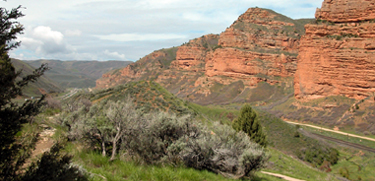
Mormon Trail
The Mormon Trail is the 1,300-mile (2,100 km) long route from Illinois to Utah on which Mormon pioneers (members of the Church of Jesus Christ of Latter-day Saints) traveled from 1846–47. Today, the Mormon Trail is a part of the United States National Trails System, known as the Mormon Pioneer National Historic Trail.
Mormon Pioneer National Historic Trail
November 10, 1846
The Mormon Trail extends from Nauvoo, Illinois, which was the principal settlement of the Latter Day Saints from 1839 to 1846, to Salt Lake City, Utah, which was settled by Brigham Young and his followers beginning in 1847. From Council Bluffs, Iowa to Fort Bridger in Wyoming, the trail follows much the same route as the Oregon Trail and the California Trail; these trails are collectively known as the Emigrant Trail.
The Mormon pioneer run began in 1846, when Young and his followers were driven from Nauvoo. After leaving, they aimed to establish a new home for the church in the Great Basin and crossed Iowa. Along their way, some were assigned to establish settlements and to plant and harvest crops for later emigrants. During the winter of 1846–47, the emigrants wintered in Iowa, other nearby states, and the unorganized territory that later became Nebraska, with the largest group residing in Winter Quarters, Nebraska. In the spring of 1847, Young led the vanguard company to the Salt Lake Valley, which was then outside the boundaries of the United States and later became Utah.
During the first few years, the emigrants were mostly former occupants of Nauvoo who were following Young to Utah. Later, the emigrants increasingly included converts from the British Isles and Europe.
The trail was used for more than 20 years, until the completion of the first transcontinental railroad in 1869. Among the emigrants were the Mormon handcart pioneers of 1856–60. Two of the handcart companies, led by James G. Willie and Edward Martin, met disaster on the trail when they departed late and were caught by heavy snowstorms in Wyoming.
Background[edit]
Under the leadership of Joseph Smith, Latter Day Saints established several communities throughout the United States between 1830 and 1844, most notably in Kirtland, Ohio; Independence, Missouri; and Nauvoo, Illinois. However, the Saints were driven out of each of them in turn, due to conflicts with other settlers (see history of the Latter Day Saint movement). This included the actions of Missouri Governor Lilburn Boggs, who issued Missouri Executive Order 44, which called for the "extermination" of all Mormons in Missouri. Latter-day Saints were finally forced to abandon Nauvoo in 1846.[1]
Although the movement had split into several denominations after Smith's death in 1844, most members aligned themselves with Brigham Young. Under Young's leadership, about 14,000 Mormon citizens of Nauvoo set out to find a new home in the West.[2]